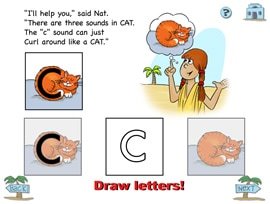Learning To Read The Right Brain Way With Talking Shapes - Review
Do you find teaching reading stressful? It can be very hard for young children to remember the phonic sound each letter makes let alone the name of the letter or how to blend sounds.
Disclosure: I received a free copy of this product for review, all opinions are 100% my own.
I recently shared about a reading program from Talking Fingers Inc. that's working really well for my son. So when I heard about their new program Talking Shapes: A Supplemental Curriculum for Early Literacy I couldn't wait to try it out.
Talking Shapes
Talking Shapes is the new online version of their app Talking Shapes: A Supplemental Curriculum for Early Literacy.
Talking Shapes is a reading program for young children in preschool and kindergarten age and teaches using a right-brain story format.
The background of the story is that 2 sisters invented the alphabet many, many years ago. They wanted a way to remember their words and stories and not have the sounds just fly away.
Talking Shapes teaches 40 different phonemes and the letters that stand for these sounds. Lessons are taught in 8 different storybooks that work like units.
Multi-Sensory Reading Lessons
Talking Shapes uses a multi-sensory method to teach children how to read.
First children hear the sound when the program reads them a story.
Then they practice writing the letter using the mouse.
After writing practice they play games where they drag the letters into the correct box to spell the word.
Using Talking Shapes In Our Homeschool
I wasn't sure at first if Talking Shapes would be a good fit for us because of the low age range it's intended for. I'm so glad that I didn't let that stop me from trying it!
What first attracted me to Talking Shapes is that they use a right-brain approach to teaching reading.
All of my children are right-brain dominant and some are also dyslexic. What's the difference you might be wondering? Basically, right-brained children don't learn to read the same way that left-brain dominant children do.
A Brief Example of Left Brain, Right Brain & Dyslexia
A left-brained person learns to read by memorizing letter names and sounds and blending them together. They normally learn how to write and spell at the same time they learn to read. They are part to whole thinkers and often learn how to read at a young age.
A right-brained person is a whole to part thinker. You see words like pictures and have a difficult time memorizing phonic sounds and blending them to make words. Reading, spelling, and writing are all learned as separate skills on a different timetable. Most reading programs are not set up for right-brain dominant learners and this can cause a lot of stress when trying to teach your children to read.
Dyslexia signs are very similar to the struggles right-brained people face when learning to read, write and spell. From what I've studied over the years most people who are dyslexic are also right-brained the difference is as they get older the struggles continue.
When I first looked at Talking Shapes what I noticed is that they use a right-brain reading method of imposing the letter shape as PART of the picture not just simply placing the letter above or on top of it.
This method helps right-brain children to associate the word or letter with a picture in their memory.
For example, using the letter S as a snake picture or using a C as a curled-up cat.
I've been using Talking Shapes with my 8-year-old who is a beginning reader and right-brain dominant. She is LOVING Talking Shapes.
This reading program is very easy for her to use because the stories are read out loud to her. She just has to click through the story. Then when it's finished she can practice working with the sounds she just heard in the story.
What I Love About Talking Shapes
The letters are connected to pictures. This gets your right brain engaged and helps with memory.
Children need to connect the sounds together as they build a word. This is a great visual way to show how the blending works.
Finished words are shown with the pictures, they can see the word as a series of images. This helps with memory and later with spelling.
What I Would Like To See Improved
Talking Shapes takes a long time to load when you first log in. We normally have a blank screen on our computer for almost a minute. Little children tend to get impatient waiting! I would love to see the loading time improved.
I also found that when my daughter was "writing" the letter shapes with the mouse she could scribble all over it and it would fill it in correctly. This doesn't really help with proper letter formation. I did encourage her to take it slowly and follow their letter-writing demonstration.
We also tried using Talking Shapes online program on my Android tablet but it kept crashing so we decided to only use it on our laptops. It also wouldn't work with my touch screen to write the letters only with the touchpad or mouse.
Overall I've been very happy with Talking Shapes and more importantly, my daughter is loving the program! It moves slowly and is very visual so it is helping her to remember the letters and words better than most reading programs we have tried.







